Younger Four & Older Four Years
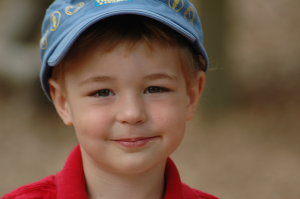 Background: The Gesell Institute of Child Development has observed that children go through a repeating sequence of six different stages with predictable changes in mood and behaviour in each. Four Years includes two such stages, each six months long. The behaviour observed in these different stages reflects qualities associated with the planets – with Jupiter and Saturn qualities respectively. The developmental traits in these profiles represent only one aspect of children’s behaviour and may be masked, modified or intensified by other factors, both individual and environmental, such as temperament, gender related behaviours, high stress levels, over-stimulation, too much screen time or organic problems.
Background: The Gesell Institute of Child Development has observed that children go through a repeating sequence of six different stages with predictable changes in mood and behaviour in each. Four Years includes two such stages, each six months long. The behaviour observed in these different stages reflects qualities associated with the planets – with Jupiter and Saturn qualities respectively. The developmental traits in these profiles represent only one aspect of children’s behaviour and may be masked, modified or intensified by other factors, both individual and environmental, such as temperament, gender related behaviours, high stress levels, over-stimulation, too much screen time or organic problems.
Note: If your child has turned this age but shows none of these behaviours, please read the previous age level, or just wait a few months, then read this again!
These profiles integrate the wonderful descriptions from the Gesell Institute of Child Development research and the ideas of Rudolf Steiner into my own research. Direct quotations from the Gesell Institute’s books are in ‘single quote marks’.
View/download pdf Four
Younger Fours – Four to four & a half years.
A stage with Jupiter qualities
In Younger Fours we see qualities and motivations traditionally associated with Jupiter: a celebration of personal power, open-heartedness, big picture thinking, dramatic gestures, expansiveness and versatility. These are the basis of what with maturity can develop into good leadership, organisational skills and wisdom.
Developmentally, Younger Four is an expansive age. They can be joyous, exuberant, outgoing, enthusiastic, energetic, ready for anything and highly sure of themselves. They love anything new, in adventure, excursions and excitement.
By Four the children have a new awareness of self and in particular a new consciousness of the power in themselves and others. Gesell researchers say: ‘All of a sudden he discovers that the adult, though still quite powerful, is not all-powerful. [Four] now finds much power in himself.’ Power is a motivating factor for Four and is enthusiastically explored. Their enthusiastic expression of self and power often manifests in ways that are socially unacceptable: they can be out of bounds both physically and verbally: they can be speedy, noisy, boastful; they exaggerate, tell tall tales, name call, behave in silly, ridiculous ways. They love to talk and to shout.
Younger Fours can also be highly versatile: quiet/noisy, calm/ assertive, cosy/imperious, suggestible/ independent, literal/ fanciful, indifferent/ inquisitive as well as social, athletic, artistic, cooperative, forthright, humorous and dogmatic.
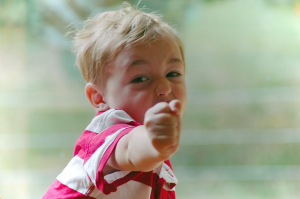
Physically, their drive is boundless; they love to run, climb, gallop, dash here and there; they need opportunities for big play and varied movement for its own sake, especially outdoors. They welcome the difficult, the daring and the different. They are quick in decision and action. They are better coordinated than before in both large and fine movement. They have more inner awareness of what they can do, of feelings inside the body, of their muscles and may even want you to feel them. “I’m tough!” they may say. They love movement for its own sake; they love whirling, swinging, somersaulting. Their movement is even exaggerated in their big gestures. This love of athletic activities is characteristic of the Jupiter stages.
Younger Fours have increased attention spans and are able to concentrate on an interesting manual task for some time. They have lively minds, new thoughts and ideas; bits of information please them. They ask why incessantly and lead adults to information giving and conversation! Their fluid imagination can lead to wonderful creative play.
The emphasis in physical growth at Four is well established in the chest and rhythmic system, and associated with this we can observe maturation in the areas of their feelings, imagination and social relationships. Their love of other children’s company and friendships can be strong. The physical expression of their affection is evident, as is their wish to please their friends, with the frequent use of words which check on the others’ feelings on a matter like “I’ll do this, okay?” Fours may still exclude, but cooperation, sharing and taking turns comes more easily— perhaps the excitement of sharing outweighs the wish to control others.
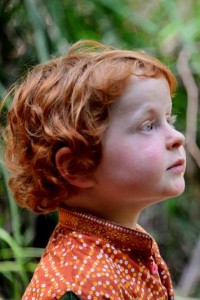
Fours build a sense of who they are by comparing themselves with others, comparing their bed, room, house, father, with other beds, rooms, houses, and fathers. This can bring out embarrassingly boastful, unsocial comments. “My birthday cake was bigger than yours”, “I’m the bestest swinger”. Their sense of self is being refined.
At Four, children still need protection and enrichment (but not over-stimulation) of their senses. They still cannot separate themselves from heavy negative emotions of those around them, including those emotions made alive by adults in story-telling or on television. They may go pale with the tension of listening to, or watching, a story being told in a frightening manner. At the same time they test themselves out and practice dealing with their fears in their talk and their play. Their stories and threats can be disturbingly violent, and were so even before TV came to feed them with violent images. “If you don’t do that I’ll cut you up into pieces and throw you in the garbage.” They often fear fire, yet may threaten (in pretence) to set fire to you. It is not surprising that they also have nightmares.
Emotionally too, Younger Fours can be excitable, dramatic, extreme and out of bounds. They can laugh too hilariously when pleased, howl and cry almost too loudly when things go wrong. Their behaviour can be very silly. They may hit, kick and spit if aroused. They love a lot and hate a lot, sometimes unpredictably- a particular vegetable, a certain person. They exaggerate: “as high as the sky”, “ten million bugs’, “as big as a house”. They boast. The boys may swagger. They love bigness in everything.
Fours’ task is to continue to make sense of the world, to find the rules, the standards. We see this in language; they are learning in a quite amazing way the standard language rules but still have not refined their language use to include all exceptions (for example, the rule is to add an “s” for plural and mouse becomes mouses, no?). They try to make sense of the world around them. So “fat bellies” may mean a person is pregnant even if it is a man. Once they find the pattern for something, they may be reluctant to give it up. “Mother cannot be a daughter too!” Fours are strongly attached to mother (or major carer), and may feel a hatred of anything that changes her ‘pattern’ or how she appears to the child— different jewellery, hair do, a displeased look on her face.
Similarly they are building up images of, and rules about, what it means to be a boy or a girl, and will show great resistance to breaking these “rules”. So one four-year-old Australian boy absolutely refused to wear a kilt (a skirt!) at a wedding in Scotland until he saw that lots of the men were wearing kilts (which changed his rule about what makes a man!).
Their own expansiveness is sometimes too much for them. They like the security of regularity, routines, boundaries and rules which adults provide, despite the fact that Younger Fours’ out of bounds tendency will urge them to test these. An objective, “this is the rule here” stated by the parent helps them to pull back. They enjoy recognising a rule and acting it out—“It’s always so and so…” They also like verbal restraints (and the new responsibility of keeping to it) such as “just go as far as the tree”.
Considering all these characteristics it is not really all that surprising to find that the testosterone (measurable in the blood) doubles in boys at four, and drops again at five. (Girls also have testosterone, though at much lower levels, and it would be interesting to see if their levels also rise at this age.) Testosterone is associated with three tendencies: (from Raising Boys, Elium and Elium p. 12) firstly, aggression and dominance, secondly, impulsive risk taking, and thirdly a ‘tension and release loop’ compulsion to experience tension and quick gratification. So the three things Elium suggests boys always need to know are: 1. Who’s in charge? 2. What are the rules? 3. Will those rules be fairly enforced? These are also good guidelines for four year olds. All Fours want and need the adults around them to have strong inner authority, to be authoritative, the ”author” of their own lives; a mere show of directives and outer authority, will not do nor draw the best out of them.
Fours show an interest in bathrooms, toilets and also other people’s toilet functioning. They may be private about their own toilet activities and may lock the bathroom/toilet door. Sex play happens easily at four usually in the form of comparing the characteristics of girls and boys, men and women. The tensional overflow outlet is often genital especially in boys. Elimination swearing has begun- “poo-poo”, “wee-wee” amuse them as does the notion of “garbage”’. These behaviours offer an ideal opportunity to continue protective behaviours education—in emphasising the right of each person to privacy and respect for genital areas and indeed all their bodily processes. This is an important part of building healthy personal boundaries.
Fours imitate swearing (sensing the power in words?) without necessarily knowing the meaning of the words used. They may use language to threaten adults—“You rat!” Sometimes it helps for the child to have their own expressive gobbledygook words to let their strong feelings out. They love words and exaggerations and, with a little encouragement, will soon find something suitable for themselves.
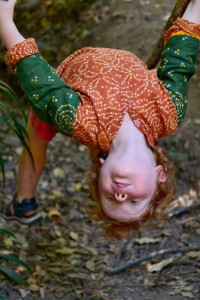
With siblings, Fours can be good but can also be unpredictable and may get on better with friends, whom they choose, than siblings. They are still not to be trusted with younger ones especially if Fours are feeling displaced, for example, by a new baby. They can be extremely aggressive and directive or bossy towards older siblings.
Fours learn best by example and by opportunities to imitate and practice through working with adults and big, creative play with open-ended materials, which allow the use of imagination.
Overall, there are many as yet immature Jupiter qualities to be seen in Four’s behaviour; they explore their personal power with great enthusiasm; everything is big and expansive, adventurous, with high drive; they are egotistical, dramatic and they exaggerate; their interests are broad; already they have lively minds, asking questions, searching, not just about practical things but also more abstract concepts like “God” and “wholeness”.
Some of these behaviours in Younger Fours can be challenging for adults, yet what a wonderful opportunity for the child to practice confidence, courage, adventurousness and big thinking – qualities which can prepare them for leadership and service to humanity in the future. It is even more wonderful when adults can enjoy and celebrate this self-assertiveness and power the children experience, while still providing them with the clear boundaries and guidance that Younger Fours most definitely need.
It is not too early to find imaginative ways to help them deal with their volatile emotions and self-centredness—to speak of ways to “tame the angry dragon”, or to “quieten that bossy bull”, or respect the “quiet place” that others might need. Children need to learn ways to show healthy exuberance without tyrannising others but we need to teach them how to do this. Their self-centeredness can be met by the encouragement of compassion; they can show great gentleness and awe at times, especially in nature. Encourage them to observe and imitate rather than chase the seagulls or touch and damage the butterfly! We can also model how to apologise and show humility when appropriate ourselves. In this way we teach them to use their personal power wisely and responsibly.
We need to learn how to consciously draw out the good from children with trust in their potential wisdom and good intentions, qualities so strongly associated with a mature Jupiter type. Research is confirming that we are essentially social beings and prefer to do things for the common good if given half the chance. Children respond to our belief in their potential strengths and their good intentions. In trying to understand their behaviours we should not assume they act out of adult (and often neurotic) motives as is so often done. They are children and behave in challenging ways most often simply to get their needs met; this is often the best place to start when they are difficult: what are they really asking for here? The article on Avoiding trouble with young children explore some sources of trouble applicable to Fours.
So enjoy your Younger Fours! Let their wonderful energy enliven you as well! At about Four and a half years, new more inward qualities start to manifest.
Older Fours- Four & a half to Five Years.
A stage with Saturn qualities
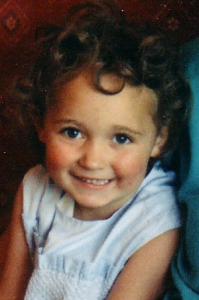 The Gesell researchers saw Older Fours as being in an in-between stage, between an extroverted ‘wild and wonderful’ Four and a calm, adaptable Five. They saw Older Fours as sometimes a bit confused, possibly unpredictable and uncertain, ‘inwardised and neurotic’ and in ‘disequilibrium’. Not such a positive picture. Yet it is possible that this stage associated with Saturn qualities is not so clearly understood, and perhaps that is not surprising because one Saturn characteristic is that they do not self-disclose easily. In fact there are many new qualities and motivations in the behaviour of Older Fours which are similar to those associated with Saturn: a move towards protection of their inner freedom with more self-containment than earlier; a deeper sensitivity; a drawing inwards; a consolidation and perfecting of skills, with focussed attention, interest in details and structure.
The Gesell researchers saw Older Fours as being in an in-between stage, between an extroverted ‘wild and wonderful’ Four and a calm, adaptable Five. They saw Older Fours as sometimes a bit confused, possibly unpredictable and uncertain, ‘inwardised and neurotic’ and in ‘disequilibrium’. Not such a positive picture. Yet it is possible that this stage associated with Saturn qualities is not so clearly understood, and perhaps that is not surprising because one Saturn characteristic is that they do not self-disclose easily. In fact there are many new qualities and motivations in the behaviour of Older Fours which are similar to those associated with Saturn: a move towards protection of their inner freedom with more self-containment than earlier; a deeper sensitivity; a drawing inwards; a consolidation and perfecting of skills, with focussed attention, interest in details and structure.
Older Four also show a lack of concern about any disequilibrium between themselves and the world, because their relative independence protects them against that, which means this is not a people-pleasing age like Five is. Saturn has also been traditionally associated with individual-ness and one’s destiny, with self-motivation, perseverance and self-consciousness. Glimpses of many of these qualities can also be seen in the behaviours of Older Fours described below.
In Older Fours the emphasis in physical growth is starting to move down into the limbs and the metabolic system, which is associated with new forces of the will, and increasing interest in power and control of action. We see this in that older Fours are more self-motivated than earlier, have more perseverance and are more interested in doing things well. They are relatively more self-sufficient and can stay on task better, with less need for adult control. Their fine motor control is better. Their play is less wild, less out of bounds and most are better able to stand frustrations.
There are also new qualities in the children’s thinking that reflect Saturn tendencies; they like to focus and refine their abilities down to a sharper point; they are interested in gathering new information and are concerned with detail and realism, sometimes even in a confronting way for adults, for example, when they demand all the details about a death. They love discussing things, the pros and cons and, as Gesell says, are ‘prompted by an intellectual philosophising sort of interest.’ They love the ritual of prayer and may be helped by it.
Similarly there is a certain Saturn-like sensitivity in Older Fours’ feelings, and a growing consciousness and awareness which brings new insecurities and which perhaps leads to them being described as ‘bothered, confused, unpredictable, and uncertain, with alternations of laughter and tears.’ They can be scared by stories which they used to love. Like Younger Fours they still have nightmares. Their grasp of reality, versus make-believe, is still tenuous and of central concern to them with the often-asked question being “Is it real?” Their imaginations at this age are very vivid. Their ability to discriminate between reality and fantasy in ‘screen time’ is still limited. Parents need to be very discriminating about what Fours watch and how much. Young children can sometimes be confused, and consequently frightened by, pretend play (e.g. daddy pretending to be an elephant) or a pretend figure (like Santa Claus).
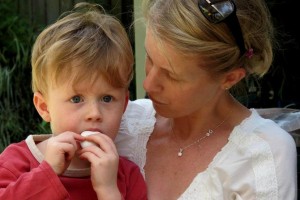
Older Fours can also worry a lot, for example, they might be scared they will die. They are sensitive to adult authority and may be more confused and fearful of strong parental reprimands. Gesell says that in Older Four ‘a new kind of confused but listening expression, mixed with a bit of fear, crosses his face when a parent reprimands him.’ It is a time for adults to adjust their own approach to this new mood in the child and to also be more sensitive!
Older Fours are also learning more about their own and other people’s power and are more resistant in defence of their own inner freedom to choose. True to Saturn qualities, they are not so amenable to just please others. They are less easily shifted than earlier and can be persistently demanding when they want something—to the point of being obnoxious. It is less easy to distract them with humour, and facing resistance, they may poke out their tongue and make dreadful faces. They are, however, developing a sense of doing things in return for something so, as adults, it is possible to temper our demands and bargain with them.
Their awareness of “good” and “bad” is beginning to dawn and they love to hear true stories about themselves or their parents, especially about how good or bad they were. Again, like for Younger Fours, this is a time to try to draw out the good in children, by acknowledging and letting them know you believe in their best qualities, their growing strengths and trustworthiness (rather than only chastising them for their misbehaviour.) “You are very good at being gentle with the cat.” “What a good ‘quiet voice’ you can use!” Noticing and affirming good character traits builds good character traits!
New power relationships can also be observed in the way Older Fours, especially boys, handle leadership- some lead, others seem willing to carry out orders. Girls lead in a more social, rather than a task oriented way, and may buzz around one girl like workers around a queen bee!
So after all the expansiveness of Younger Fours, Older Fours start to draw inwards and consolidate their sense of self and their abilities, experiencing the world with new sensitivities and new ways of thinking. They need us to respect this inwardness, this self-protectiveness, this new kind of independence, although we might not fully understand it. Working with insight about the Saturn qualities, we can help them by giving them order, predictability and stability and by being well organised ourselves. They do not like chaos and hurriedness.
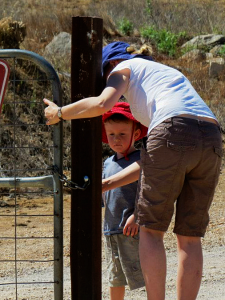
More than ever Older Fours need time and our patience. Time for doing things. Time to prepare themselves inwardly, for transitions, to let go of things. We can enter into the story of their play to imaginatively lead their play to a completion and to prepare the way for something else: “Your farmer on his truck has been working very hard. He must be getting hungry for his tea. He can park his truck in the shed and come inside.” They need time to practice what they want to perfect.
Older Fours also need us to connect deeply with them, to be loyal to them, to trust them, for they want to be good. Their increased sensitivity allows them to read more into our non-verbal communications than we might think. We need to understand and accommodate this extra sensitivity, protecting them from over-stimulation, from violent images or disturbing stories. We need to let them be shy again if they want to be shy, to withdraw into a quiet place if they need that. They may need to sometimes not do things after all the energetic adventure of Younger Fours.

Our western culture does not encourage sensitivity and shyness, yet the learning from the deep feeling behind these qualities is what helps children to develop compassion and empathy for others, to develop love of nature and the earth. They will need every bit of the learning that this special sensitivity gives them. We also need to celebrate their capacity to be strong enough in themselves to not feel pressured to do things just to please others, but to do what they think is right. This is the beginning of personal integrity.
So Younger Fours present us with new challenges in an age with more special gifts for us all, if we can but slow down and become aware of them.
View/download pdf Four
Further reading
Bates Ames, L, and Ilg, F. L. Your Four Year Old Wild and Wonderful (A Dell Paperback, New York, 1976) A Gesell Institute of Child Development Book.
Payne, Kim John, with Lisa M. Ross Simplicity Parenting Using the Extraordinary Power of Less to Raise Calmer, Happier and More Secure kids. (Ballantine Books Trade Paperbacks, New York, 2009) Or their website: www.simplicityparenting.com
See also
Avoiding trouble with young children
Strategies for healthy living with young children
Healthy play
Family celebrations
Brief descriptions of the planetary qualities